How Are Diamonds Made? Natural vs Lab-Created Explained
Two Paths, One Diamond Not all diamonds come from the same place — but they all start the same way. Pure carbon, crystalized under immense pressure and heat. Whether it…
This Ultimate Diamond Buying Guide is your comprehensive resource for purchasing a diamond in 2025. Whether you’re buying for love, celebration, or investment, this guide provides expert insights to help you make informed decisions with confidence. From mastering the 4Cs to understanding the importance of certification and vendor policies, you’ll find everything you need here.
In 2025, the diamond market is more dynamic than ever, with new trends, advanced tools, and evolving buyer preferences shaping how we shop. This guide will cover:
Choose the perfect diamond in 2025 here:
Find Your Perfect Diamond. Explore PriceScope’s Premium Diamond Search Tool to compare prices from top vendors in real time. Access exclusive insights to make informed decisions. Search Diamonds Now
Online diamond shopping has transformed, with interactive tools and expert advice making it easier than ever to find your perfect stone.
John Pollard, PriceScope’s Educational Advisor, explores the latest trends in buying natural and lab-grown diamonds online.
Diamonds are emotional and financial investments. Here are the top reasons to buy a diamond:
Engagement traditions remain the most popular reason to purchase a diamond. Find the perfect stone to symbolize your commitment.
Whether it’s an anniversary, birthday, or personal milestone, diamond jewelry adds brilliance to every special moment.
Create a lasting legacy with a diamond that can be passed down through generations as an heirloom.
The natural diamond market has proven to be more resilient than expected, with natural diamond prices rising steadily while lab-grown diamond prices continue to decline.
Celebrate personal achievements or life milestones with a diamond that reflects your individuality.
Protect Your Precious Investment. Ensure peace of mind with BriteCo Insurance. From engagement rings to heirloom diamonds, safeguard your jewelry against loss, theft, and damage with trusted coverage. Get Insured Today
What To Consider Before Buying A Diamond?
Determine what works for your finances and matches your recipient’s expectations. Learn more about how much to spend on an engagement ring.
With many options available, it’s worth taking time to get fully educated. Start with PriceScope’s educational resources and tools for better decision-making.
Why Diamond Shape Matters
The shape of a diamond serves as the foundation for its overall aesthetic and is pivotal to the design of the final jewelry piece. While the round brilliant remains the most popular and versatile shape, a wide array of alternatives offers unique appeal and distinctive styling options.
Grading Standards: It’s important to note that shapes other than round are not typically graded for cut, a critical component influencing a diamond’s brilliance and fire. This lack of standardized cut grading for fancy shapes necessitates a nuanced understanding when assessing their quality.
Length-to-Width Ratios: The length-to-width ratio provides a numerical representation of a diamond’s proportions, which significantly impacts its appearance. For example, a diamond with a length of 6.00 mm and a width of 4.00 mm has a ratio of 1.5:1, creating a balanced rectangular profile.
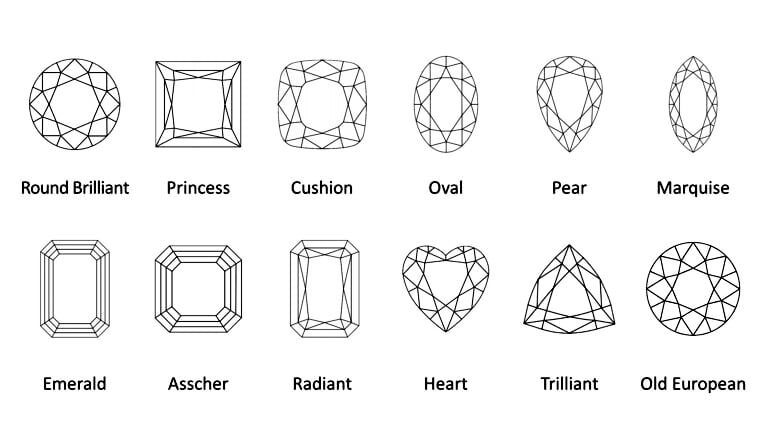
This ratio numerically illustrates how long and wide the stone appears from the face-up view. Expressed as “L:W”, it’s determined by dividing the length of the diamond by its width. For example, if a diamond had a length of 6.00 mm and a width of 4.00 mm, the length-to-width ratio would be 1:5.
Shape-Specific Characteristics
Choosing the Right Carat Weight
*PriceScope Priceless Tip: You can’t judge a diamond’s size by its carat weight, you need more information.
Understanding Carat: Carat weight, equivalent to 200 milligrams, is a primary factor influencing a diamond’s value. However, a diamond’s visual size is also dictated by its cut quality and dimensions.
Selecting Carat Weight with Confidence
Superior cut quality complements carat weight by maximizing visual spread and brilliance. For instance, a 0.80 ct diamond with excellent cut proportions may appear larger and more vibrant than a poorly cut 1.00 ct stone.
Proportionate Spread
Diamonds with optimal proportions balance depth and table size, ensuring no light is lost to leakage. A diamond’s grading report provides its external measurements in millimeters, allowing professionals to assess its physical spread and face-up size accurately.
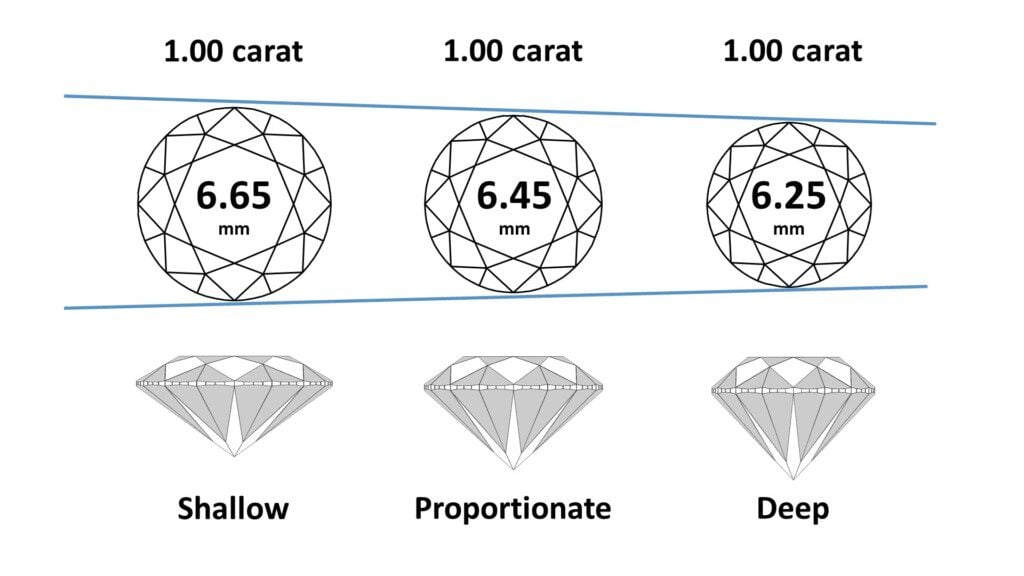
The best carat weight is one that has proper physical and visual spread, looking as large as it should in all lighting environments. Choosing a 1.00 ct diamond over an 0.80 ct diamond makes no sense if the 0.80 ct diamond appears larger than the 1.00 ct diamond in normal lighting.
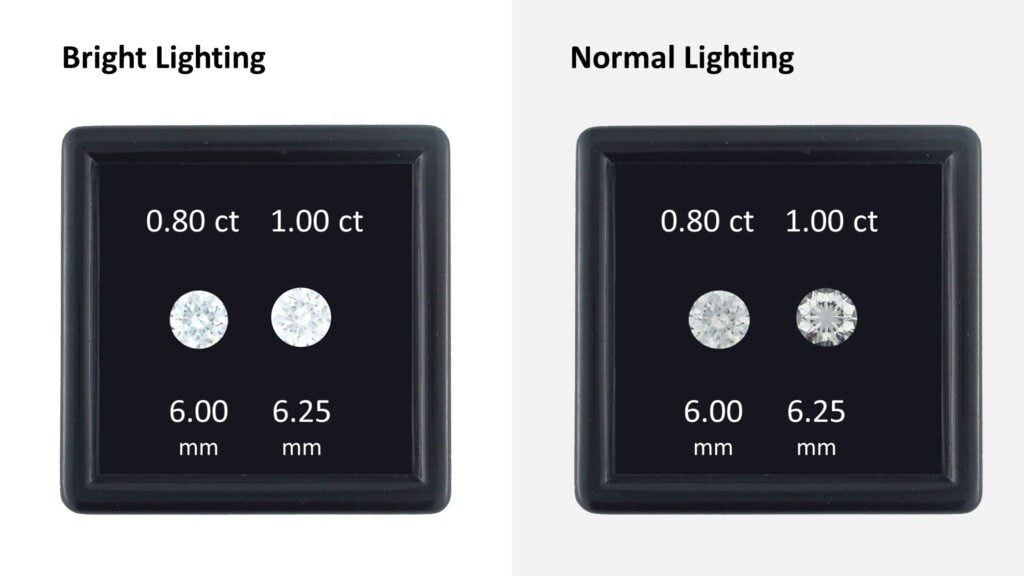
The Importance of Diamond Cut
*PriceScope Priceless Tip: Unlike color and clarity, where high grades are strict and rare, more than 60% of round brilliants receive the “Excellent” cut grade, so you need more information to make decisions.
Cut quality holds unparalleled significance in determining a diamond’s overall appearance and value. While high grades for color and clarity often show minimal variation, diamonds with the same “top” cut grade can differ significantly in brilliance and fire. This variability underscores the critical need to assess cut beyond surface-level grading labels, as over 60% of round brilliants receive an “Excellent” grade, yet only a fraction achieve optimal light performance.
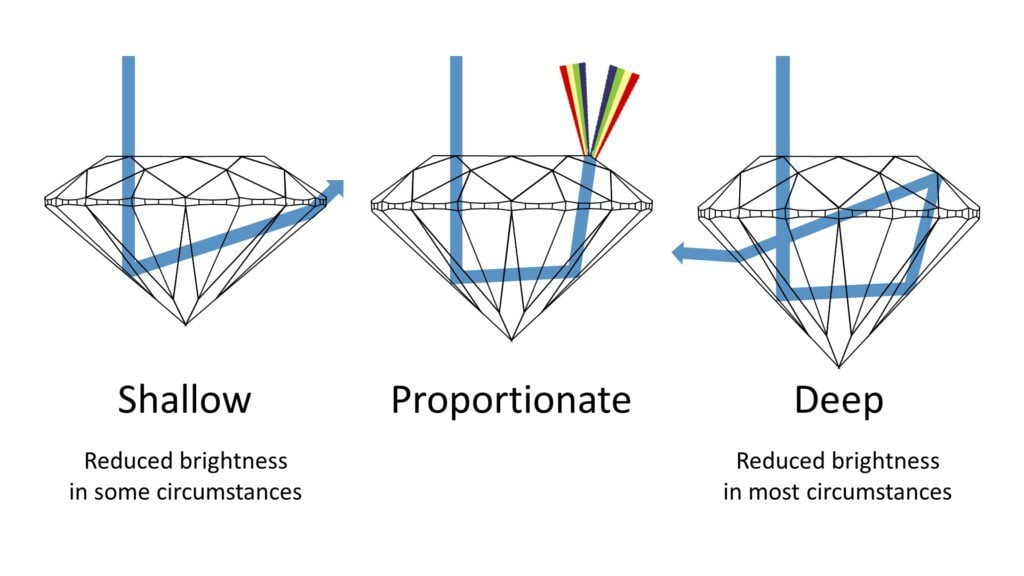
Key Points on Diamond Cut Grading and Its Impact
Weight Retention Over Beauty: Many diamonds are cut to prioritize carat weight rather than brilliance. Such steep-deep cuts maximize yield but compromise light return, creating darker, less lively stones.
The PriceScope community refers to several subsets of round brilliant diamonds. Steep-deep diamonds are most abundant. Producers use wide (steep deep) cutting angles to increase the diamond’s final weight, maximizing yield. Unfortunately this reduces their size appearance and creates darkness when removed from bright lights. The PriceScope Ideal is cut with proportionate angles which successfully reflect and return light back to the viewer’s eyes as brightness, fire, contrast, and sparkle. The Super-Ideal is a rare subset, cut within a small range of scientifically proven “ideal” proportions and further fine-tuned to display Hearts & Arrows in a specialized viewer.
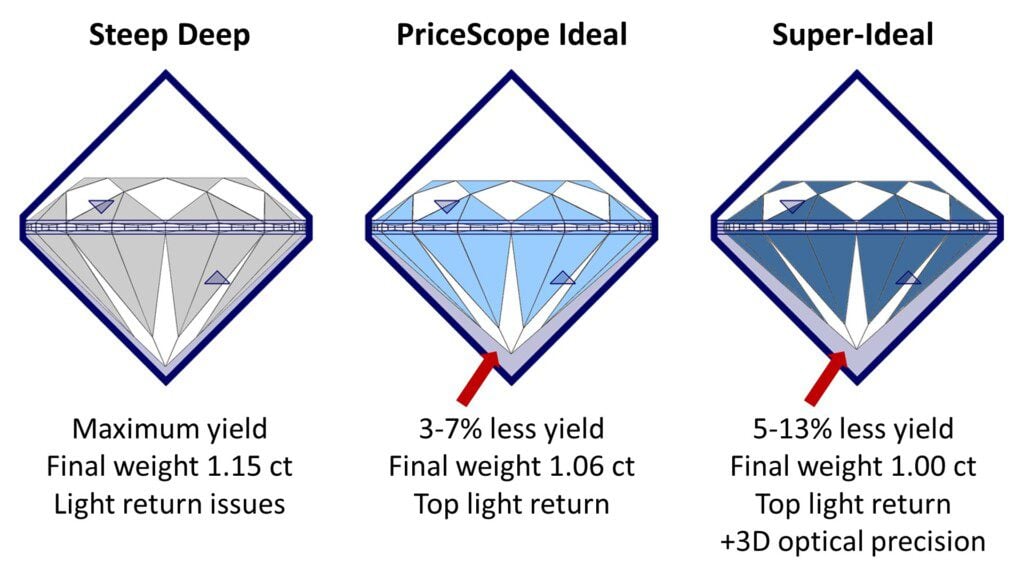
The Holloway Cut Advisor (HCA) is an analytic tool that uses measurements of a round brilliant diamond to calculate potential light return, fire, scintillation and spread. When you register with PriceScope you can analyze three diamonds for free. HCA scores are also included in PriceScope round diamond search results.
Use Our HCA To Hit The Cut Quality Bullseye
The Ideal Scope is a portable diamond brilliance and leakage gauge. A lens with a hot pink reflector lets you see how much light comes from a diamond to your eyes. The most brilliant diamonds have pink/red (brightness) with a symmetrical black star (contrast) and minimal white or pale areas (leakage).
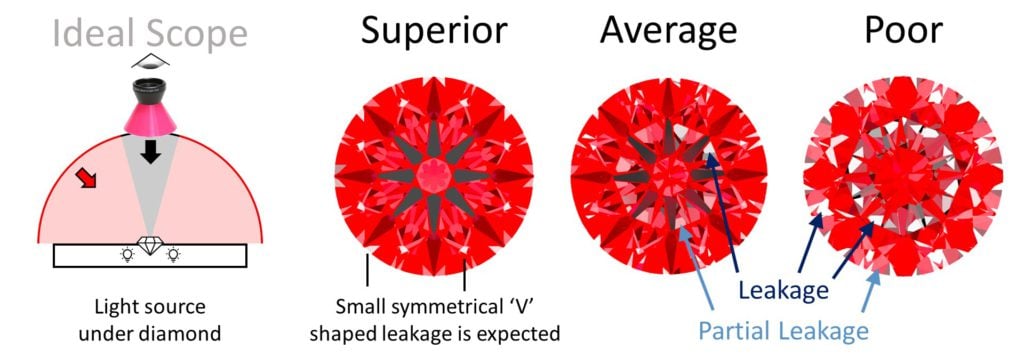
Light entering a diamond will either reflect and shoot up to the viewer’s eyes (as brightness) or escape through the bottom (as leakage or windowing). In general terms, brightness is desirable, leakage is to be avoided.
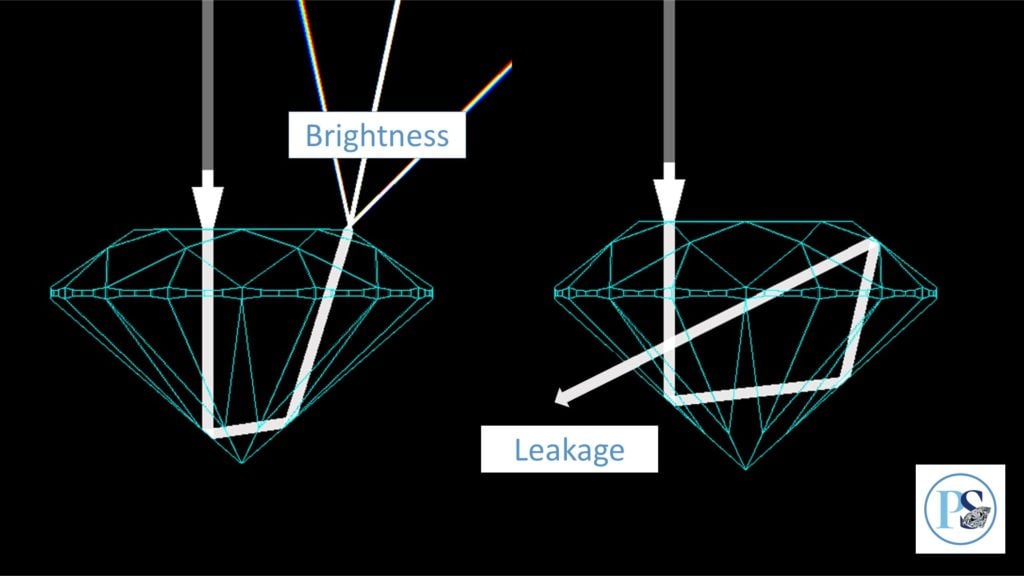
*PriceScope Priceless Tip: The most purchased diamond colors are F-G-H or I, set in white gold or platinum.
Diamond Color influences price the most after carat weight. A diamond’s color was caused by chemicals in the earth where it formed. Most of the world’s diamonds are yellow or brown. The objective for most people is to get a diamond that appears colorless, also described as “white.”
Most diamonds are graded on a scale ranging from D, which has the least color, all the way to Z, which is light yellow or possibly light brown. Other colors, and stronger levels of yellow and brown, are classified as fancy colored diamonds, and are graded on a different scale.
Most people cannot detect a difference of 2-3 color grades unless the diamonds are placed next to each other, especially in the colorless (D-E-F) and near-colorless (G-H-I-J) ranges. With that said, taste comes into play. For those who love the icy appearance and rarity of a colorless diamond the extra spend may be worth it.
Fancy shapes may reveal more color than round brilliant cuts in the face up position because they have broader facet arrangements. This is largely a non-factor in diamonds graded DEF. The potential for more visible color appearance or color concentration increases the more you consider diamonds graded GHIJ and below.
Yes. Gemological laboratories perform D to Z color grading with the diamond upside down and viewed through the side because of three factors which may influence color appearance in the “face-up” position: The diamond’s shape, the way the diamond was cut and the possible presence of diamond fluorescence.
Yes. As they get larger in size, diamonds show more color. As diamonds increase in carat weight the presence of color becomes more noticeable, simply because whatever color exists throughout the diamond occurs takes on more mass. The presence of color in diamonds graded K and below becomes especially noticeable at weights above 2.50 – 3.00 carats.
Undisclosed undertone is something that isn’t disclosed on diamond grading reports. It’s a subtle or not-so-subtle brown, grey or green undertone which influences overall color appearance. This issue is disclosed among traders but isn’t always communicated by diamond sellers to consumers.
Remember that diamonds are color-graded upside down, viewed through the side. “Face-up” color is the diamond’s color appearance when viewed from the top. In well-cut diamonds light gets in and out on shorter ray-paths with greater intensity. This can cause the appearance of less color when the diamond is seen from the top.
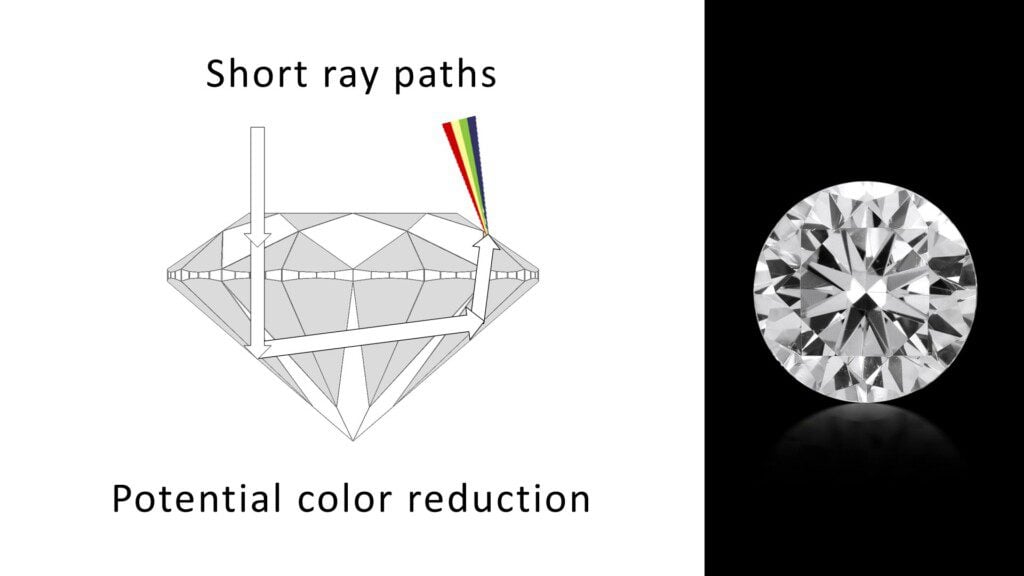
Alternately, if the diamond is cut so that light escapes through the bottom – or bounces around inside – the color within that diamond may be exaggerated when seen from the top.
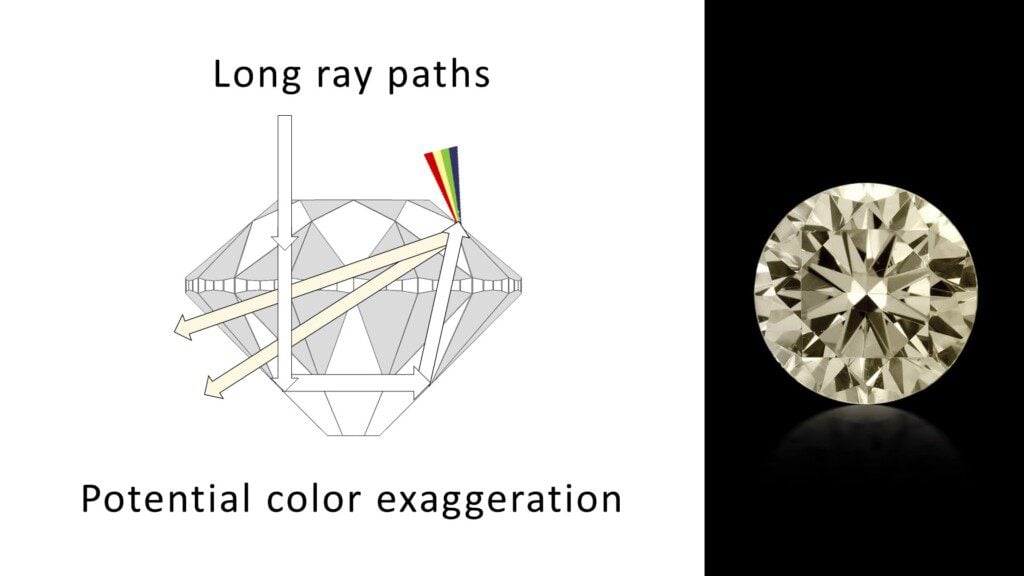
Round brilliant diamonds benefit from kite-shaped facets which promote sparkle, so they can be set in white metal in colors from D-J. Colors below J are well-suited for yellow metal settings. Colors with brown undertone look great in rose-gold settings. Fancy shapes are recommended for setting on a different schedule. See all metal recommendations here.
Diamond Color influences price the most after carat weight. Collection quality diamonds are those with color and clarity combinations which trade for the highest values and continue to hold that value best over time. Combining a non fluorescent, D color, E color, or F color with Flawless, Internally-Flawless, VVS1 or VVS2 clarity gives a diamond collection quality status in the eyes of diamond professionals and enthusiasts. Some people choose high color and clarity combinations for this reason.
*PriceScope Priceless Tip: The most purchased clarity grades are VS1, VS2 and “eye clean” SI1.
– Definition on diamond clarity.
The world’s natural diamonds formed between 1-3 billion years ago, 100 miles beneath the earth’s surface. As they grew, chemicals and elements present in the earth became trapped within their crystal lattices. Diamond Clarity evaluates a gemstone’s relative freedom from such internal characteristics, classified as inclusions, and from surface characteristics, classified as blemishes.
A gemologist analyzes clarity by looking down through the top of the stone at 10-power (10X) magnification. All inclusions and blemishes seen at 10X are considered when deciding the clarity grade. There are 11 different clarity grades.
Inclusions are characteristics trapped within the diamond.
Twinning Wisps Inclusions shown below
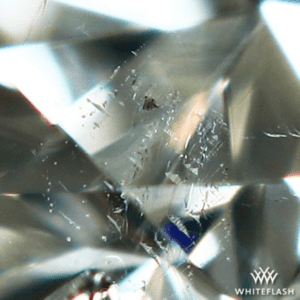
Image Source: Whiteflash
Many people just want an “eye-clean” diamond, meaning one which has no inclusions invisible to the naked eye. There is no laboratory definition for this, but a PriceScope survey of gemologists resulted in this consensus:
Eye-Clean: No inclusions visible to the unaided eye when viewed from the face up position in daylight equivalent or fluorescent lighting between 6-12 inches from the eye using 20/20 vision.*
See a diamond clarity chart showing eye-clean clarity grades.
Eye-clean is determined when viewing a diamond with the naked human eye. 10X examination is performed viewing the diamond with a magnifying loupe or microscope.
Successful online sellers like our recommended PriceScope vetted vendors, have methods of reliably classifying and communicating diamond clarity, whether you’re examining it in-person or purchasing online. They also offer liberal inspection periods and free returns so you can make your purchase with complete confidence. You can read about how to choose diamond clarity with confidence here.
In addition to visibility at 10 power magnification, gemologists also consider Location, Number, Color, Size and the Nature of inclusions and blemishes when deciding the diamond clarity grade. You can read definitions for each of those additional factors on our Diamond Clarity page.
In clarity categories VS2, SI1, SI2 and below the comments “clouds not shown” or “additional clouds not shown” typically indicate the diamond grader considered them a non-issue. The comment is simply on the record for other gemologists who may examine the diamond later.
Since clarity grading is limited to 10X magnification characteristics beyond that scrutiny can go unreported. Undisclosed diamond haze is caused by large clouds of microscopic pinpoints when they become dense enough to interfere with light transmission and reduce transparency.
Trade members may refer to hazy diamonds as being “sleepy stones,” a phenomenon which occurs on a sliding scale. Slight cases may not even be noticed by the average jeweler. In moderate cases the diamond will seem to need a cleaning when seen in some lighting environments. In the most severe cases the diamond is notably reduced in its performance qualities in all lighting environments.
*PriceScope Priceless Tip: For risk-free purchases, generous policies and robust consumer protection, consult our list of 5-star PriceScope Vetted Vendors.
As the world’s largest diamond and jewelry community, PriceScope is a place where many would like to advertise and list products. Few meet our standards. PriceScope Vetted Vendors provide safe online purchase experiences with generous inspection periods, hassle-free returns, and standout long-term benefits for clients.
PriceScope’s Vetted Vendors meet or exceed PriceScope’s rigorous requirements for truthful advertising, best business practices, and proactive consumer protection. They deliver the high-quality customer service standards developed by over 100,000 PriceScope members over the past 20 years.
We take the trust of our members very seriously – to protect our diamond and jewelry community, each of our potential associations involve a thorough vetting process. This often takes more time and effort, but it helps ensure the vendors who meet our requirements are the most consumer-friendly, setting industry benchmarks in truthful advertising, best business practices and consumer protection.
Components we have considered include, but are not limited to: Company history, including founders/owners, reviews/ratings and references. Truthful advertising, including messaging philosophies, proper promotion of strengths, proper use of terminology and industry esprit de corps. And best business practices and consumer protection through product selection, information provision, education, policies and short, mid and long-term client experience.
*PriceScope Priceless Tip: Make sure your diamond comes with a grading report from the GIA, IGI, AGS or GCAL.
Diamond Certificates (or grading reports) are issued by an independent gemological laboratory, following a secure, standardized diamond grading process. It’s an assessment of the diamond’s 4Cs, which are used to establish its value.
The GIA is the most widely recognized gemological institute, considered the world’s foremost authority on diamonds, colored stones, and pearls. A public benefit, nonprofit institute, the GIA has been the leading source of knowledge, standards, and education in gems and jewelry.
The IGI is the world’s largest gemological organization, operating 18 laboratories and 14 schools of gemology around the world. In addition to being the world leader in lab-grown diamond grading IGI issues grading reports for finished jewelry, serving more consumers than any other lab.
The AGS began grading diamonds in 1996 and is best known for their strict cut and performance standards. The AGS Platinum Report is the certificate of choice for diamond brands renowned for superior cut quality. They are one of two top-tier laboratories offering cut quality assessments for certain fancy shapes.
The GCAL, established in 2001, is the only laboratory issuing diamond “certificates” backed by a guarantee. The GCAL focuses on diamond cut analysis, using a copyrighted diamond-specific performance assessment method, and provides a unique diamond fingerprint known as Gemprint. They are one of two top-tier laboratories offering cut quality assessments for certain fancy shapes.
Generic reports accompanying economical pieces like those seen in mall or department store jewelry counters should not be confused with loose diamond certification (or grading reports). These documents are not item-specific, they are mass-produced to describe a production run of numerous similar pieces. They are not nearly as strict, accurate or expensive as stand-alone diamond grading reports or jewelry identification reports, prepared for a specific piece.
Yes. Diamond grading scales are calibrated to three decimal places. Most laboratories establish carat weight to two decimal places, with the exception of the AGS, which reports to three.
Diamond color employs the alphabet, starting with D (colorless) and progressing from E to Z as the presence of tint increases. Diamond clarity uses a set of acronyms in a diamond ratings system which is not as intuitive as color and clarity. The grades are subjective decisions made by trained gemologists examining the stones.
Diamond cut grading is treated differently from lab to lab. Why? Because color and clarity have been strictly graded since the 1950s, but the world’s largest laboratory, the Gemological Institute of America (GIA), didn’t grade cut until 2006. By then, other diamonds ratings systems for cut had been launched by other laboratories. As a result, there are a number of different approaches to grading cut.
No two diamonds are alike. Color and clarity occur on a sliding scale and a diamond sitting directly on the border of two grades may come out on one side of the other, depending on the subjective opinion of the gemologist making the judgment. To that end, a standard deviation of +/- one grade is generally deemed acceptable among professionals.
Under grading occurs when a jewelry professional intentionally claims a diamond has lower grades than it would normally receive according to strict, industry-accepted international standards. The goal of intentional under-grading is to win consumer business by creating fear-based doubts about other professionals.
Any diamond of value should be accompanied by a grading report from a top-tier laboratory. Expensive jewelry pieces should either be accompanied by a finished jewelry grading report or, at minimum, come with a grading report describing the central gemstone. For inexpensive pieces, full grading may not be practical.
Laboratory analysis and grading charges are largely based on the diamond’s carat weight. For a one-carat loose diamond, the charge has historically landed near $100. There are many services offered by the different grading laboratories. Consumers may contact them for full explanation of services and fees.
Presuming you stay with certification from a top-tier diamond certification laboratory, diamond ratings for color and clarity will typically remain within one grade for any specific diamond. Considering how granular and subtle those diamond ratings systems are, a one grade difference is technically negligible. Of course, those values are used to establish a diamond’s value so it’s in the best interest of shoppers to use the strictest set of grades.
*PriceScope Priceless Tip: Do not expose gemstone jewelry to mechanical cleaners. Learn our Seven Steps to Sparkle.
Your jewelry was designed to be worn. Frequently and proudly. You will be able to keep your jewelry in top condition by learning How to Clean Jewelry.
Yes. Each day, before retiring follow this Careful Cleaning Credo: Remove all jewelry and wipe each piece down with a clean soft dry cloth to remove perspiration, chemicals, etc. This prevents buildup and helps maintain optimum beauty between professional cleanings.
Engagement Ring Insurance is a personal decision, but diamond is the hardest material known to man, but even the most flawless diamond can chip if struck along its crystal’s cleavage plane. For this reason, we believe every diamond owner should carry insurance.
Yes. Enlist the help of a professional jeweler every so often to deep-clean and check integrity. How frequently depends on your wear habits – as a general rule we recommend once or twice per year.
Periodically it’s prudent to perform thorough home jewelry cleaning. Due to their superior hardness, toughness, and stability, there is a seven-step process that can be safely performed with diamonds. Other jewelry should be considered on a case-by-case basis.
Clean the bottom of the diamond regularly with a soft brush. Light enters the stone from above, but the bottom facets play a critical role in both reflection, which helps the stone be bright, as well as refraction. Light that would normally reflect gets drawn out by grease or oil on the underside. This mutes how diamonds and gemstones sparkle.
If you clean your diamond and gemstone jewelry after each use according to this credo, and additionally clean daily-wear jewelry using these careful seven steps once per week your visits to a professional will be less frequent. Nevertheless, for deep cleaning we recommend visiting your jewelry pro once or twice per year.

Image Source: Whiteflash
Whiteflash is renowned for its precision-cut diamonds, known as A CUT ABOVE®. These diamonds are among the finest in the industry, offering exceptional brilliance and sparkle. Here’s what you can expect from Whiteflash:
Whiteflash’s signature A CUT ABOVE® diamonds are designed with unmatched precision for maximum light performance. They provide a wide range of GIA and AGS-certified diamonds, ensuring transparency and quality.
Whiteflash offers a wide range of engagement ring settings, and they excel in custom design. The “Dreams of Africa” collection features ethically sourced diamonds that support African communities.
Exceptional customer service with expert gemologists to assist you throughout the buying process. Lifetime trade-up and upgrade policies ensure long-term satisfaction.
Whiteflash A CUT ABOVE® Diamonds. Shop Whiteflash's premium range of A CUT ABOVE® diamonds, known for their exceptional precision and light performance. Perfect for the most discerning buyers.
James Allen is known for its vast inventory of diamonds and interactive 360-degree HD videos of each stone, allowing you to examine diamonds up close. Here’s what sets them apart:
Their high-quality images and videos provide a detailed view of each diamond, enabling you to assess clarity and color with confidence. An extensive selection of lab-certified diamonds ensures diverse choices.
A user-friendly website and dedicated customer service make the buying process straightforward. James Allen’s “Diamond Display Technology” allows you to virtually view diamonds before purchase.
Competitive pricing and a wide range of price points cater to various budgets. Frequent sales and promotions provide additional savings opportunities.
Shop James Allen’s TRUE HEARTS™ Collection. Examine diamonds up close with James Allen’s TRUE HEARTS™ diamonds, featuring premium-cut diamonds that sparkle with perfection. Enjoy 360-degree HD views of every stone.
Blue Nile is a well-established online diamond retailer, known for its vast selection and competitive pricing. Here’s what you need to know about Blue Nile:
Blue Nile offers a wide range of diamonds, including fancy shapes and rare stones. They also have their very own diamonds collection, Astor Their virtual gemologist tool assists in choosing the perfect diamond based on your preferences.
Competitive pricing and transparent diamond pricing charts help you make informed decisions. Blue Nile offers a “Build Your Own Ring” feature for customization.
Blue Nile’s educational resources, including guides and articles, are excellent for first-time buyers. Customer reviews and ratings provide insight into other buyers’ experiences.
Shop Blue Nile’s Astor by Blue Nile™ Collection. Choose diamonds that excel in brilliance, fire, and scintillation. Astor by Blue Nile™ diamonds are independently certified for superior light performance and crafted to the highest standards.
Adiamor is a family-owned business with a strong reputation for quality and customization. They offer a variety of settings and diamonds to suit different tastes and budgets:
Adiamor specializes in custom engagement rings and offers a range of design options. Their team of experienced jewelers can help bring your vision to life.
All diamonds are hand-selected and come with GIA or AGS certificates for quality assurance. The company is known for its commitment to ethical sourcing.
Adiamor offers a 30-day return policy and a lifetime warranty on their jewelry, ensuring peace of mind.
Shop Adiamor’s Affinity Cut Diamonds. Experience superior quality with Adiamor’s Affinity Cut Diamonds, designed for brilliance and crafted to the highest standards.
Choosing a diamond is a significant decision, combining beauty, value, and personal meaning. With this guide and PriceScope’s trusted resources, you can navigate the diamond-buying journey with confidence. Take the time to understand what matters most to you, and you’ll find a diamond that you’ll treasure for years to come.

Retail Diamond Prices Chart Updated Monthly.

Two Paths, One Diamond Not all diamonds come from the same place — but they all start the same way. Pure carbon, crystalized under immense pressure and heat. Whether it…
A Wedding Ring as Unique as Your Love Finding the right wedding ring isn’t just about diamonds or gold – it’s about finding the one that feels right. With hundreds…
So, you’re thinking about lab-grown diamonds? Smart move. They’re just as sparkly as the natural kind but usually cost less. But where do you actually go to buy them? It…

Want to stay updated on the most recent blogs, forum posts, and educational articles? Sign up for Bling News, PriceScope’s weekly newsletter.